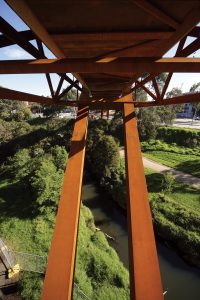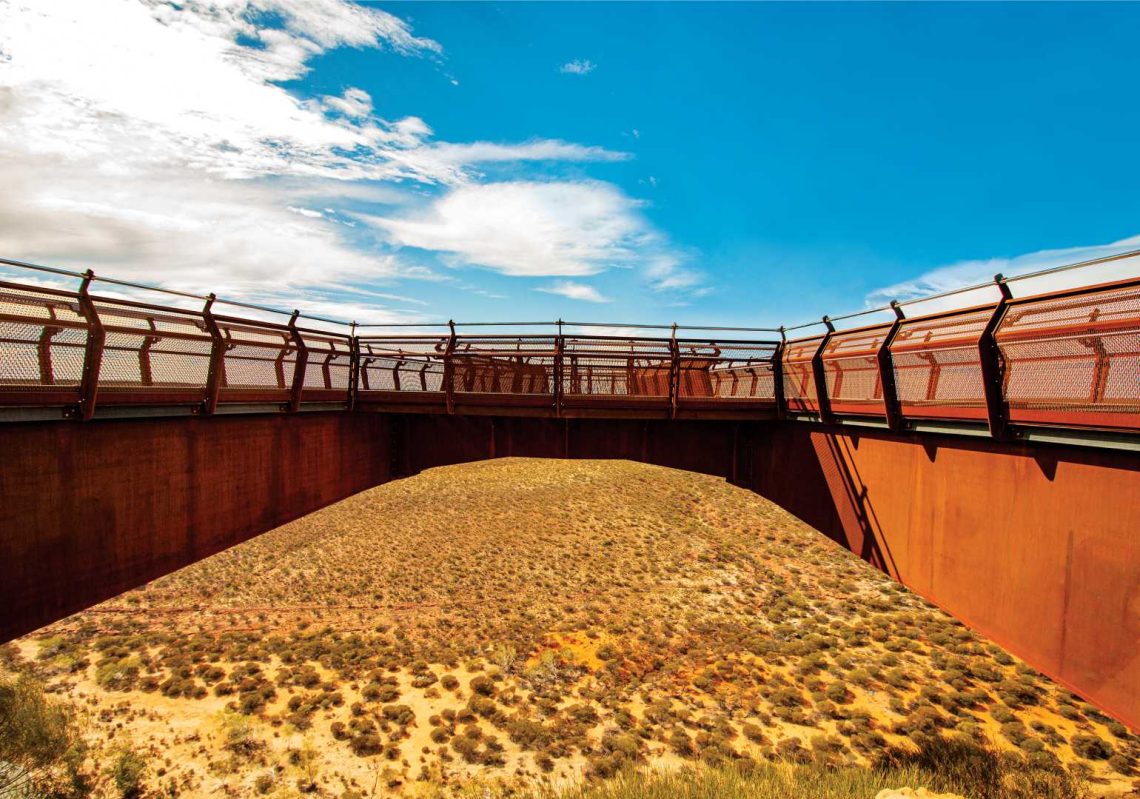Bridges made from weathering steel can last over 100 years without a single coat of paint. No wonder the structured steel alloy is becoming the go-to metal for civil engineers and architects planning a host of major infrastructure projects.
The Picton River Bridge was built for Tasmanian Forestry in a remote area of unspoilt national park in the state’s south in 1981. Over the subsequent decades, it’s remained remarkably unchanged, aside from the colour of its steel girders and bolts morphing from vibrant russet to an attractive dark chocolate.
No one has had to paint or repair the metalwork – and it’s unlikely they will for many decades to come – because the modest structure was made from a type of steel that’s surprisingly rare in Australia.
But all that is beginning to change as engineers and architects discover the many benefits of weathering steel, and realise its potential to transform bridge building.
The structured steel alloy’s enhanced atmospheric resistance results from its unique blend of copper, chrome, silicon, nickel and phosphorus alloying elements. Unlike most other carbon-manganese steels, it develops a stable oxide patina that forms a protective barrier against oxygen, water and other contaminants that prevents further corrosion.
Steel appeal
Driving the surge in demand for the specialist alloy are two companies on a mission to put it at the heart of major infrastructure projects by demonstrating how it’s a compelling alternative to reinforced concrete and other types of steel.
BlueScope is the only firm to manufacture the REDCOR weathering steel product in Australia, and was approached by Hobson Engineering, the market leader for high precision steel bolts and fasteners, to discuss supplying weathering steel bolts in metric sizes that comply fully with Australian standards (AS/NZS 3678:2016 Structural steel – Hot-Rolled Plates, Floorplates and Slabs). Hobson can now deliver them much more quickly than when they had to be ordered from abroad.
Hobson has worked closely with infrastructure engineers to supply the exact weathering steel bolts required for a series of major projects and test them thoroughly in its labs. Prior to its involvement, such products had to be imported in Imperial sizes from the US, sometimes with no guarantee of compliance.
Why choose weathering steel?
The potential advantages of weathering steel can be numerous:
- For bridges, little or no maintenance over a 100-year lifespan.
- Faster, cheaper construction.
- Eliminates the need to recoat meaning no road or rail closures and improved sustainability outcomes.
- High strength to weight ratio, allowing longer spans.
- Lower lifetime costs.
- Premium bolts in metric sizes.
- All steel visible for inspection.
- Fabrication possible off-site in controlled workshops.
- Lighter cranes needed onsite.
BlueScope has been testing weathering steel in a range of environmental conditions throughout Australia for over 50 years to analyse performance and gain insights into its suitability for different climatic conditions.
It’s now widely used to make shipping containers, iron ore rail cars, bridges, fences, building wall claddings, sculptures and landscape features. Its earthy patina’s appearance also makes it ideal for sculptures and outdoor art.
“It’s a fantastic product for so many reasons,” said Rob Danis, BlueScope’s National Engineering Manager for Infrastructure. “Standard steel flakes off over time so has to be galvanised or painted regularly, but weathering steel is pretty much maintenance-free when designed and detailed correctly in the right environment. It’s also great to look at at every stage of its patina development.”
Major weathering steel constructions
Concrete bridges became the norm in the 1980s and have remained popular since, but weathering steel girders and bolts are gaining in popularity, and being used for several major projects.
- The elegant Kalbarri Skywalk in WA is composed of cantilevered box beam structures over the Murchison River Gorge that are fabricated from BlueScope’s REDCOR weathering steel and bolts from Hobson.
- Also in WA, the old Fitzroy River Bridge on the Great Northern Highway in the Kimberley was badly damaged by Ex-Tropical Cyclone Ellie in December last year. Its replacement is already underway and will contain over 10,000 weathering steel bolts. It’ll be the first bridge that the asset owner, Main Roads WA, has constructed with REDCOR weathering steel beams.
- The 200-metre Molonglo River Bridge in the ACT will be the country’s longest REDCOR weathering steel bridge when it opens to traffic in 2025.

“We’ve always enjoyed partnering with Hobson,” said Danis. “The fact that Australian engineers can now access high-quality weathering steel bolts that comply with Australian standards is a significant step forward and will make REDCOR weathering steel an even more desirable product for designers and architects.”
Forest rangers driving over the Picton River Bridge probably don’t give it a second glance, but it’s testament to the beauty and longevity of weathering steel that’s becoming increasingly integral to some of our most important infrastructure projects.
Find out more about Hobson Engineering and Bluescope’s weathering steel solutions.




